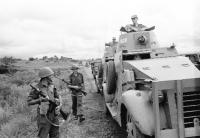Irish wheels on African soil: the Ford armoured car
Published in
20th-century / Contemporary History,
Features,
Issue 6 (Nov/Dec 2010),
The Emergency,
Volume 18

Irish UN troops from the 38th Infantry Battalion with two Ford Mk VI armoured cars, securing positions around the perimeter of Elisabethville, on the road from Kipushi, 3 January 1963. One is currently on permanent display
During the Emergency (1939–45) the Irish Army lacked much of the essential equipment needed to defend Ireland, and naturally it was not possible to import armoured vehicles from abroad. To overcome this, Major J.V. Lawless of the Cavalry Corps designed a number of armoured cars based on various truck chassis that were then built in Ireland. In 1941 Thomas Thompson and Son of Carlow were commissioned to manufacture 28 armoured cars based on Lawless’s designs. By taking a Ford 1?-ton truck chassis made in Cork and adding armour and a turret with a .303-inch Vickers machine-gun, a useful vehicle capable of defending airports and escorting convoys was created. But in the absence of four-wheel drive it had no cross-country capability.
Twenty years later, in January 1961, eight of these
armoured cars, followed later by three more, were flown to the Congo by the US Air Force to assist Irish soldiers serving in Ireland’s first United Nations mission there. The previous November nine Irish soldiers had been killed in a ambush by Baluba tribesmen and, although a peacekeeping mission, it was clear that armoured vehicles would now be needed. Before going to the Congo the armoured cars were painted white, but this coating quickly disappeared in the heat and combat to reveal the standard Irish Army colour of Quaker grey underneath. Later, as the fighting became more severe, UN vehicles were painted in olive green to help camouflage them.
The armoured cars were to see more action in Africa than in Ireland, with four of them lost in combat. During the siege at Jadotville in September 1961 two Ford armoured cars fired 15,000 rounds of ammunition over four days while defending Irish soldiers. In the same month, an armoured car was involved in an ambush in Elisabethville, which led to the deaths of Cpl Michael Nolan and Tpr Patrick Mullins of the 35 Infantry Battalion. Between July 1960 and May 1964, 6,400 Irish soldiers served in the Congo, of whom 26 lost their lives, including sixteen in combat. The six surviving vehicles were handed over to the Congolese Army when the Irish left. HI
Lar Joye is curator of military history at the National Museum of Ireland (Decorative Arts and History).

One is currently on permanent display (inset) in the Soldiers and Chiefs: the Irish at Home and Abroad from 1550 exhibition at the National Museum, Collins Barracks. (Military Archives and National Museum of Ireland)


















